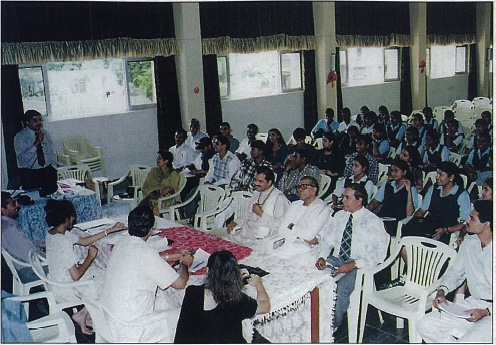By Meera Vayapooree
Soul searching is what a group of youth were called upon to do during a symposium on what it means to be young and Hindu in this new millennium. The symposium was held in the Indian Ocean island republic of Mauritius earlier this year. Drawing participants locally and from eastern Africa, it was organized by the Hindu Council of Africa in collaboration with Hindu House and the Human Service Trust of Mauritius. The latter is a charitable trust founded under the guidance of the late Swami Krishnanand and the former a socio-cultural organization.
Among the 150 young participants was Bijal Patel from Tanzania, a diamond bank trust employee in Dar es Salaam. She arrived on the island a few days before the symposium to attend Maha Sivaratri, our largest festival, which is increasingly attracting international pilgrims. She and fellow participant Anjali Sham, a senior administrator in the private sector in Kenya, were awed with the festival’s fervor and devotion, especially among the young.
The festival centers on a volcanic lake called Grand Bassin, or Ganga Talao, just south of the central part of the island. It’s revered as a sacred lake by generations of Hindus. Tens of thousands of pilgrims from all over the island undertake a pilgrimage on foot each year to collect sacred water from the lake. They take this water back to the temples in their localities and on Maha Sivaratri day offer it to Lord Siva. “It’s like the whole island became one big temple,” said Bijal Patel.
One convention topic was the role of Hindu youth in community service projects. Bijal felt Hindus have much to offer in terms of service. The older generation in Tanzania (with about 11,000 Hindus), Bijal said, “keep telling us we are the future and must do more.” For her, this principally means continuing with traditions and service to the community–not just to the immediate Hindu circle but to the wider community.
Anjali believes that perhaps the foremost contribution of Hinduism to the modern world is its core value of ahimsa, nonviolence. She is very clear about what this means: “Ahimsa is about being nonviolent not just in your actions, but also in what you are thinking and speaking.” She found the symposium raised relevant issues which touch the lives of Hindus. They both consider physical or verbal abuse of children wrong and against the principle of nonviolence. Their solution to this is greater communication between the parents and children and a kind of retraining of the parents.
Hindu education was a prime topic at the convention, and Anjali explained that there was a time when Kenyan Hindus had no provision in their country’s education system for Hindu studies. But then the Hindu Council of Kenya came up with a Hindu syllabus which has since been integrated into the curriculum. Bijal said she has learned about her religion and culture away from the mainstream Tanzanian education system. Her family and local socio-cultural organizations have nurtured the values she cherishes today.
Both Bijal and Anjali feel they are getting enough support from their elders and guidance about what being a Hindu is. Anjali thinks that this is a central question, really knowing what it means to be a Hindu: “No one can call himself a Hindu if he does not practice noninjury.” She goes so far as to say that anyone who sincerely practices nonviolence is a Hindu and a Hindu who calls himself a Hindu and yet is violent towards others is not worthy of being called one.
Being a Hindu in Mauritius is a more complex issue for Chaya Chuckoury, especially as she works as a secondary school teacher. It is as important for her to be a Hindu and to be a Mauritian, “These two cannot be separated.” The island has a population of 1.2 million. Hinduism, Christianity and Islam are the principal religions. The ethnic, cultural and religious diversity of Mauritian society presents a formidable challenge to Chaya.
Unlike her coparticipants, Chaya has encountered children suffering physical and verbal abuse. She believes that re-education is needed. “Young Hindus seem to be very attracted to Western values and programs. There’s a cultural influence of violence from the West which affects the way young Hindus are behaving. There’s a generation gap and lack of communication.”
The symposium theme, the “Role and Responsibility of Hindu Youths in the New Millennium” was daunting enough. Topics included arranged marriage, making Hinduism a dynamic, frontline religion, making religion appealing to the youth, creating a Hindu pride and education and appreciation of ceremonial worship in the modern world. The enthusiasm and the strength of feeling conveyed by the participants showed that they are more than ready to embrace these issues.
